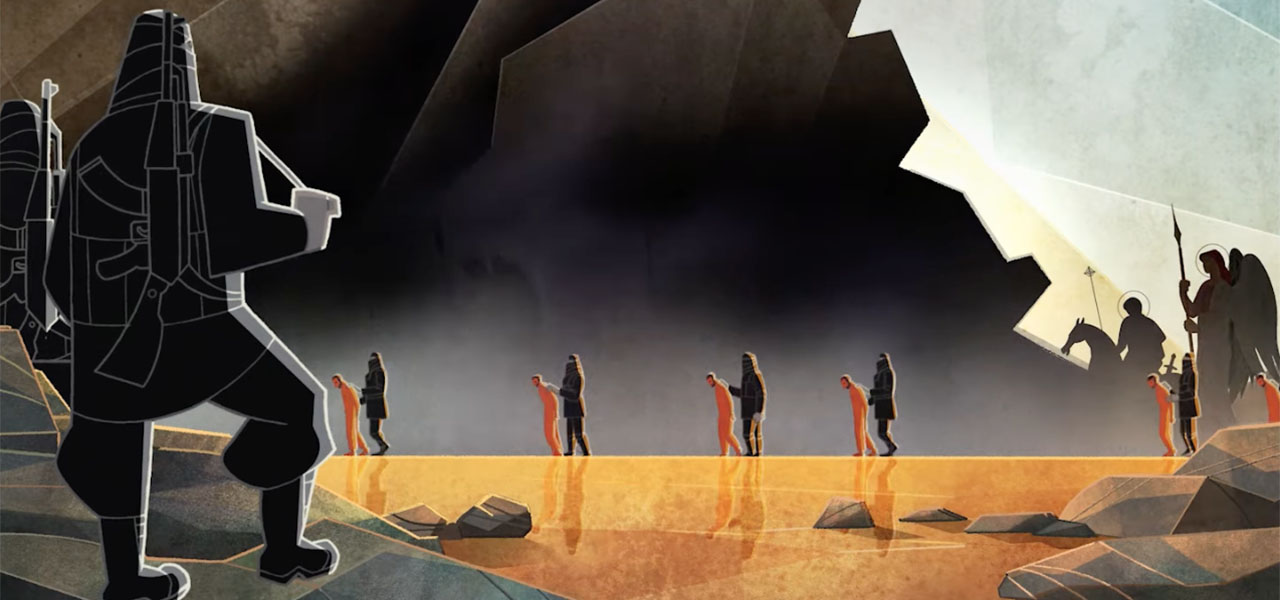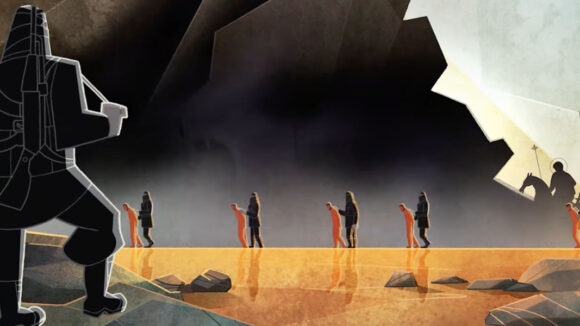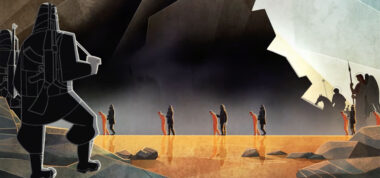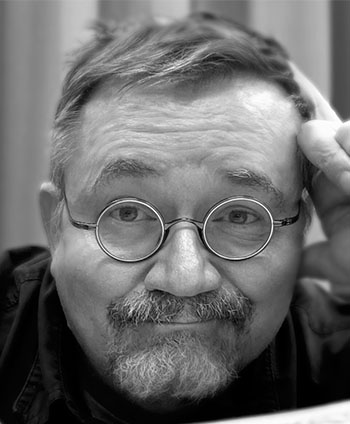

2025 Oscars Short Film Contenders: ‘The 21′ Director Tod Polson
Cartoon Brew is putting the spotlight on animated short films that have qualified for the 2025 Oscars.
In this installment, we’re looking at The 21 from American filmmaker Tod Polson. The short earned its Oscars qualification through theatrical exhibition.
A short film honoring the 21 Coptic men murdered by ISIS in Libya in 2015, The 21 is crafted in the style of Coptic iconography by a global team of more than 70 artists from more than 24 countries. Mixing live-action footage with animation, the film serves as a powerful tribute to the martyrs and a vibrant message against obscurantism.
Cartoon Brew: How has Neo-Coptic iconography inspired you and your team, and how has this global community of artists been inspired by it to create this film?


Tod Polson: The purpose of an icon is to aid in devotion and contemplation, acting as a window into the divine. In the same way, I wanted each frame of the film to give the audience a greater connection to the story of the martyrs, their faith, and everything they experienced. To encourage contemplation. Stylistically, I leaned into the strong clean shapes of Neo-Coptic iconography. Many icons are painted on wood or plaster, so it was important to keep a handmade aesthetic in the textures and linework.
Most icons are composed vertically, symbolizing the relationship between God and humanity. So, I chose to frame most of The 21 in the old square Academy ratio (4:3). In the final sequence of the film the aspect ratio changes to 16:9 to accommodate the clips of live-action footage from the original ISIS video. Much of the color work was inspired by traditional iconography. Early on, Nikola Saric developed a refined color palette for me, as my initial concept paintings were overly saturated. Throughout the film, I used gold to signify the presence of God, ensuring that even in the darkest moments, subtle glints of gold illuminated the design. Blue symbolized the heavenly realm, while black conveyed the essence of evil. Each color was carefully chosen because of its traditional meaning, and to reflect and enhance the emotional depth of the story. In keeping with the tradition of iconography, many compositions in the film are grounded in divine proportions, incorporating principles such as the golden section, rabatment, and dynamic symmetry to reinforce the spiritual and symbolic resonance of the visuals. There are many other aspects of the film linked to the divine. Even if audiences don’t understand all these symbols, I hope they sense that there is more going on than meets the eye.
What was it about this story or concept that connected with you and compelled you to direct the film?
The video released by ISIS in 2015, depicting the horrific murders of 21 Coptic Christians, was shocking and deeply disturbing. The faith these men displayed in the face of death was profoundly moving. Yet, it was the response of their families and their remarkable message of forgiveness that went straight to my heart. Despite their overwhelming grief, the families rejected hatred and vengeance. Instead, they prayed for the extremists, hoping that some might come to know the love of Christ. Later, as I sat with the families of the martyrs in Egypt, seeing both pain and sincerity in their eyes, 21 blood stained orange jumpsuits in an adjoining room, their message of forgiveness became even more powerful. It was a life-changing moment.
This same testimony inspired producers Mandi Hart and Mark Rogers to pursue the idea of making a film about the martyrs. They were able to raise much of the budget through donations and crowdfunding. At the time they approached me to direct, I had recently left my position as a creative director at Cartoon Saloon to focus on more personal films exploring faith like The 21. Everything just seemed to fall into place. Though this was just one of countless violent acts in the region, the martyrs’ story shines a light on a message of forgiveness that feels especially urgent in our increasingly fractured world. The 21 does not glorify violence; rather, it exposes its absurdity.
What did you learn through the experience of making this film, either production-wise, filmmaking-wise, creatively, or about the subject matter?
Creating The 21 has been one of the biggest adventures of my life. During production, I had the privilege of meeting incredible people from around the world — journalists, iconographers, animators, theologians, and historians. When I began my research, I had only a handful of friends in Egypt and knew very little about Egyptian culture, let alone Coptic Christianity. My understanding of iconography was basic — certainly not enough to engage with it in any meaningful way. Although I’m a follower of Christ, I’ve made every effort to tell the story of The 21 from a neutral point of view. I relied heavily on accounts gathered through leaders of the Coptic church, interviews with family members of the martyrs who were in Libya at the time of the kidnappings, testimony from imprisoned ISIS guards, and reports from Libyan police and journalists embedded with the Libyan army. During the production of the film I’ve learned how dark hate can be. But the overwhelming love I’ve experienced from most everyone I’ve come into contact with has far overshadowed that.
Can you describe how you developed your visual approach to the film, why you settled on this style/technique, and how this shaped the final work?
From the beginning, it was clear that The 21 would be a 2d film. Coptic Egyptians have a long tradition of martyrdom, and creating icons of those martyrs. An icon-inspired design approach seemed the best and only real choice for the short. Icons by Nikola Saric, Edmon Kamel, and Tony Rezk, were created shortly after the ISIS video was released, and had already become powerful symbols in the Coptic community by the time I started working on the film. Fortunately all three artists were willing to speak into the style of the film. Edmon had actually painted many of the icons in the martyrs’ home church in Upper Egypt and knew the families of the men. He and his wife Marina became a great bridge to the families there.
Artists working in Lviv, Ukraine, have long inspired me. Lyuba Yatskiv, Ivanka Demchuk, Khrystyna Kvyk, Sergii Radkevych, Kostko Markovych, etc. are all doing new and exciting things with very traditional themes. Their work is very personal, being representational and emotional at the same time. I took the same approach while developing the look of The 21, soaking in different aspects of iconography and filtering it through my own worldview. The look of the film was also heavily inspired by art movements such as Vorticism, Precisionism, Futurism, and Cubism. For the most part these movements rejected sentimentality and traditionalism, and encompassed ideas of fascism. I was trying to project the emotions of the characters through a hard, shattered, broken world.
